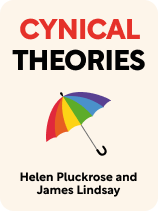

This article is an excerpt from the Shortform book guide to "Cynical Theories" by Helen Pluckrose and James Lindsay. Shortform has the world's best summaries and analyses of books you should be reading.
Like this article? Sign up for a free trial here.
What’s the best way to fight inequality in society? Why are some people anti-science? Why didn’t pure deconstructive postmodernism last longer?
Over the last few decades, advocates for social justice on the left have become increasingly radical and authoritarian in their beliefs and methods. That’s the view expressed by Helen Pluckrose and James Lindsay in their book Cynical Theories.
Read more to understand their argument and to learn what they promote as an alternative to the Social Justice Movement.
Overview of Cynical Theories
In Cynical Theories, authors and academics Helen Pluckrose and James Lindsay discuss social justice, or, attempts to address inequalities based on factors like class, race, gender, and so on. They argue that the contemporary Social Justice Movement rejects core tenets of Western liberalism—namely freedom of speech and belief in science—in favor of their own methods of critiquing and policing culture. Pluckrose and Lindsay make the case that these liberal tenets are preferable for battling inequality and improving society since they allow for open discussion and scientific progress.
(Shortform note: While the term Social Justice Movement sounds like it refers to an organized campaign or political faction, many authors, cultural critics, and politicians view the Social Justice Movement less as a single entity and more as an ideology influencing many different institutions in society—academia, corporations, and even the military. According to these authors, this influence is often top-down, with people in power enforcing the beliefs of the Social Justice Movement in their organizations. Examples of this influence include mandatory diversity training and requiring the use of gender-neutral language.)
We’ll explore Pluckrose and Lindsay’s arguments in four parts:
- Part 1: How Social Justice Changed will show how the beliefs and methods of social justice movements changed over the past 50 years.
- Part 2: The Social Justice Movement Rejects Science discusses the specific anti-science beliefs of the Social Justice Movement.
- Part 3: The Social Justice Movement Rejects Freedom of Speech describes how the methods of the Social Justice Movement repress free speech.
- Part 4: Why Society Should Return to Liberalism outlines why academia and society should return to the values of liberalism.
(Shortform note: Pluckrose and Lindsay primarily focus their critiques on the academic world, arguing colleges and universities are the sources of the Social Justice Movement. The title of Cynical Theories is a play on academic language—critical theory refers to the general style of left-wing cultural critique used by the Social Justice Movement. The cynicism, on the other hand, comes from the Social Justice Movement’s repressive and authoritarian tendencies.)
Part 1: How Social Justice Changed
Authors, academics, and cultural critics Pluckrose and Lindsay begin by discussing the history of social justice in politics and scholarship over the past century or so to show how it went from a positive force to its current form. They separate this history into three main phases:
Phase 1: Material Approaches
For a long time, social justice movements focused on material issues, or, concrete political and economic advances. Advocates for social justice had specific goals—women’s suffrage, an end to legal segregation, or legalized gay marriage, for example. The authors outline two main forms of scholarship that take material approaches to social justice: liberalism and Marxism.
Liberalism
Liberal scholars and activists believe society should be run according to reason, logic, and evidence-based arguments. Just as science uses evidence and reason to arrive at objective truths about the world, liberals argue that empirical evidence and rational debate can determine the best path forward for society. Liberal activists advocate social justice through concrete legal and political advancements, fighting for universal rights and equal treatment under the law. This ensures everyone is on an equal playing field in society.
Marxism
Marxist scholars and activists believe in historical materialism, or that all of politics and history is based on economic forces and class conflicts. This includes social inequalities. Marxists, therefore, argue the best way to address social inequality is economic change, using revolutionary means if necessary. On a larger scale, they argue socialism will create total economic equality, which will then lead to total social equality. On a smaller scale, Marxist academics study how social oppression comes from and relates to economic inequality and capitalism.
Phase 2: Postmodern Deconstruction
Pluckrose and Lindsay explain that beginning in the 1950s, a new understanding of social justice began to emerge: postmodernism, an intellectual and artistic movement focused on challenging existing understandings of the world. Postmodernists focus not on concrete material issues, but instead on how power is expressed through culture.
Though postmodernism can prove difficult to define, Pluckrose and Lindsay identify two main postmodern tenets:
1) Deconstruct All Truths
Postmodernism, the authors explain, rejects the idea of objective truth. According to postmodernist thought, anything considered to be objective truth is in fact a biased narrative, or, view of the world created by a specific culture. These narratives often exist to the benefit of people in power since those with the most power have the most control over the shaping and creation of culture. Postmodern scholarship attempts to discover power dynamics behind claims to objective truth and then deconstruct those claims by pointing out their biases and inconsistencies.
This is the foundation of postmodernism’s critique of liberalism and Marxism. Both philosophies believe people can uncover objective truths about the world—liberals through rational thought and Marxists through analyzing class conflict. Postmodernists argue these are both metanarratives, or, biased cultural lenses people use to create other narratives about the world.
2) Challenge Cultural Hierarchies
Postmodernists believe hierarchies of power exist within every social class as well as between them—people reinforce narratives through social interactions and conversations, often without realizing it. This occurs even on the level of specific language and word choices as people talking to one another imply hierarchies or echo oppressive narratives created by those in power. Because these hierarchies are everywhere at once and constantly being reinforced, postmodernists didn’t have an answer to how they could be addressed or how society could be improved. Therefore, unlike the Social Justice Movement, early postmodernists stuck to academic analysis as opposed to activism.
Phase 3: Critical Theories
Pure deconstructive postmodernism, the authors explain, wore itself out after only a few decades. Because early postmodernists didn’t believe in objective truth, they couldn’t make any arguments about how things are or should be, causing the mostly academic movement to stagnate. However, a newer generation of academics, artists, and activists in the 1990s through the 2010s modified postmodernism into critical theories, or academic fields that aim to “critique” culture by noticing and challenging specific hierarchies. For example, the academic field of critical race theory “critiques” the idea of race as a whole, challenging those who believe in it.
Pluckrose and Lindsay suggest critical theories became popular because many of the main political goals of past activists were achieved—homosexuality was decriminalized, workplace sexual harassment was made illegal, and so on. Modern social justice activists, therefore, turned away from material approaches and flocked to the culture-and-language-based approach of postmodernism.
The authors outline two main components of critical theories:
1) Postmodern Methods
While critical theories don’t subscribe to the total deconstruction of pure postmodernism, they still use methods influenced by postmodern thought. Critical theories still deconstruct dominant narratives and look for hierarchies within language, culture, and everyday interactions at all levels of society.
2) New Doctrines
Critical theories differ from pure postmodernism in that they establish their own “truths” instead of trying to tear down the concept of truth entirely. Instead of being content with questioning or deconstructing a dominant cultural narrative, they argue using that cultural narrative is morally wrong. Non-dominant cultural narratives—usually the views and experiences of minority groups—therefore must be morally correct truths.
Part 2: The Social Justice Movement Rejects Science
Now that we’ve explored how the influence of postmodernism changed social justice, we’ll discuss Pluckrose and Lindsay’s critiques of the modern Social Justice Movement. Part 2 will focus on how the Social Justice Movement’s ideology rejects science. The authors argue this is counterproductive, as scientific research provides the understanding necessary to improve people’s lives in concrete ways (we’ll discuss their arguments on behalf of science further in Part 4).
Pluckrose and Lindsay cite two main areas as representing the Social Justice Movement’s rejection of science:
Gender and Sexuality
Pluckrose and Lindsay explain that the Social Justice Movement believes gender and sexuality have nothing to do with biology, instead claiming that gender and sexuality are entirely culturally constructed narratives. Society determines what it means to be a certain gender, assigning certain activities, qualities, and things as signifiers of gender. Then, it assigns genders to people at birth and has them “perform” their gender through these signifiers.
The Social Justice Movement argues the narratives of gender and sexuality are inherently oppressive. People in power—cisgender straight men—use strict categories of gender and sexuality to define themselves as the “default” or “ideal,” and everyone else as “inferior” or “abnormal.” The Social Justice Movement believes science is often a tool of this oppression, used to argue straight, cisgender people are the norm and everyone else is disordered somehow. Therefore, the movement rejects science that claims gender and sexuality are based on inherent, objective qualities (genetic factors or brain chemistry, for example) rather than purely on cultural narratives, viewing this research as an attempt to legitimize oppressive cultural narratives.
Disability and Fatness
The Social Justice Movement views “healthy” and “unhealthy” as oppressive cultural narratives created by dominant groups in society—abled-bodied thin people, in this case—to label themselves as ideal or default and the disabled or fat as abnormal or inferior. They view attempts to treat or cure disabilities and fatness as part of this oppression since it is society enforcing the idea that it’s better to be able-bodied and thin than it is to be disabled and fat. In other words, it is society saying able-bodied thin people are superior to disabled and fat people. Therefore, the Social Justice Movement is skeptical or even hostile to scientific research trying to cure disabilities or prove why fatness is unhealthy.
Part 3: The Social Justice Movement Rejects Freedom of Speech
In addition to rejecting science, the Social Justice Movement also rejects freedom of speech, explain Pluckrose and Lindsay. Part 3 will show how the beliefs and methods of the Social Justice Movement are anti-free speech.
Anti-Free Speech Beliefs
Pluckrose and Lindsay explain that the Social Justice Movement is anti-free speech because they believe access to knowledge is based on identity—race, gender, and so on—instead of on reason and evidence. According to the Social Justice Movement, people of marginalized identities have more knowledge than everyone else about power and oppression because of their experiences. People from dominant groups lack this knowledge, and so the Social Justice Movement believes these people’s ideas about power, oppression, and social justice should be devalued or dismissed. Pluckrose and Lindsay explain this is anti-free speech since it seeks to restrict or devalue ideas based on who says them rather than on merit.
Anti-Free Speech Methods
Pluckrose and Lindsay contend the Social Justice Movement is anti-free speech in their methods, attempting to police and control people’s language and culture. Since the Social Justice Movement views oppression as the result of cultural narratives, they try to prevent people from enforcing those narratives in their language and culture.
In practice, this often means ganging up on people with dissenting ideas. The Social Justice Movement is willing to target anyone, according to the authors, because they believe power is exercised on every level of society—a working-class person making an insensitive joke, an academic writing a paper with ideas contrary to the Social Justice Movement, a celebrity making a controversial work of art, and so on. Targets of these attacks may face real-world consequences, losing jobs, being socially alienated, or even receiving threats.
Part 4: Why Society Should Return to Liberalism
After outlining historical shifts in social justice scholarship and how they led to the Social Justice Movement’s current beliefs, Pluckrose and Lindsay shift to explain why liberalism is preferable for addressing social inequality. They argue that capitalism and democracy—the two cornerstones of liberalism—are self-correcting institutions because they welcome criticism through rational debate and give the people tools (political and economic participation) to address social problems. This process of consistent improvement is preferable to the Social Justice Movement, which the authors say aims to shut down rational debate in favor of their own fixed doctrines.
To demonstrate why this is the case, Pluckrose and Lindsay show how freedom of speech and belief in science make liberalism better for addressing inequality than the Social Justice Movement:
Freedom of Expression
The authors argue liberalism’s emphasis on free and open debate among rational individuals is an excellent way to address social inequality. Freedom of speech and expression allows ideas contrary to dominant narratives to circulate freely and gain traction based on merit and leads to societal shifts when enough people conclude the status quo is unjust. In addition, emphasis on free and open rational debate encourages people to empathize and cooperate to find common ground—including with disadvantaged groups—helping people address their biases and work together to fight social inequality.
Belief in Science
Pluckrose and Lindsay also argue that liberalism’s strong belief in science allows it to challenge dominant narratives and address biases. Since the scientific method relies on evidence-based theories that are rigorously challenged and updated, it enables people to catch and correct their own mistakes—including mistakes resulting from bias. This also means the scientific community is willing to challenge dominant narratives provided there’s evidence to disprove them. The authors suggest evidence-based refutations of dominant narratives are far more convincing to the average person compared to deconstruction or policing language. Therefore, a philosophy based on science is better for getting people to fight social inequality.
Exercise: Compare Liberalism and Social Justice
Consider how liberalism and the Social Justice Movement affect inequality.
- Do you think the Social Justice Movement is addressing inequality in modern society, or making it worse? How so?
- Do you think the tenets of liberalism—free speech, belief in science, and so on—are still prevalent in society today? Why or why not?
- How can society preserve free speech while also moving away from the tenets of the Social Justice Movement? For example, this could be done by enforcing a balanced curriculum in schools with many different ideologies.

———End of Preview———
Like what you just read? Read the rest of the world's best book summary and analysis of Helen Pluckrose and James Lindsay's "Cynical Theories" at Shortform.
Here's what you'll find in our full Cynical Theories summary:
- How and why modern advocacy has gone too far
- How social justice scholarship and activism has become dangerous
- Why freedom of speech and belief in science are more important than ever






